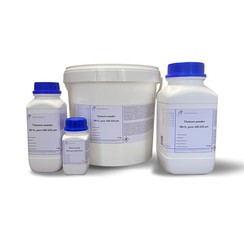You have no items in your shopping cart
Titanium
Titanium is the chemical element of the periodic table of elements that has the symbol Ti and the atomic number 22. It is a metal of block d, light, resistant, with a metallic white color, glossy, resistant to corrosion. Titanium is used in resistant light alloys and in white pigments; it occurs in many minerals, mainly rutile and ilmenite. Titanium is non-toxic and is not essential to living species.
About 95% of the titanium is consumed in the form of titanium dioxide (TiO2) in paint, paper and cement to make them brighter, and in plastics. Paints made with titanium dioxide reflect infrared radiation very well and are therefore widely used by astronomers.
Due to their mechanical strength and corrosion resistance, lightweight and ability to withstand extreme temperatures, titanium alloys are mainly used in the aerospace industry, although their use in consumer products such as golf clubs, bicycles, motorcycle parts and laptops is increasingly and more commonly used. Titanium is often alloyed with aluminum, iron, manganese, molybdenum and other metals.
Titanium carbide (TiC; specific gravity 4.93; melting point 2940 ° C) titanium nitride (TiN; specific gravity 5.40; melting point 2960 ° C) and more recently the carbonitride derivative (Ti10C7N3; specific gravity 5.02; melting point 3520 ° C) highly refractory compounds, inert under normal temperature conditions and resistant to attack by most mineral acids and lyes.
For these reasons, they are used in the construction of tools and machines that have parts intended for high speeds with friction, in the lining of crucibles containing very strong acids or bases and parts of missiles that are subject to thermal wear, for example, nozzles. .
Other uses:
Due to its excellent resistance to seawater and saline solutions in general, it is used in the manufacture of marine engine parts and very often also in watch case manufacturing;
A very important technological use, coupled with resistance to saline solutions, is as a metallic material for contact with liquids with a high salt concentration in seawater desalination plants;
It is used to make relatively soft artificial gemstones;
Titanium tetrachloride (TiCl4), a colorless liquid, is used to obtain the iridescence of glass and is also used in the manufacture of smoke bombs because it gives off a thick smoke in moist air;
In addition to being an important pigment, titanium dioxide is also used in sunscreens for its ability to protect the skin;
It has the property of being biocompatible, since the oxide layer that forms on the surface is a valid carrier to which biological tissues adhere, in particular bone tissue. For this reason, pure CP4 titanium and Ti6Al4V titanium-based alloy are used in hip and knee prosthetic components, for the manufacture of surgical clips for permanent bonding, and in dentistry for the production of dental implants. However, due to its high coefficient of friction, it is never used as a connecting component;
Due to its slowness and attractive color, it is a popular metal for piercings.
Titanium is used for eyeglass lenses;
Carbide and titanium nitride (TiC and TiN) are used in the fabrication of tool inserts suitable for cutting metal at high speed, ie so-called "carbide" inserts. Specifically, titanium carbide is used along with tungsten carbide (WC), cobalt and other carbides (niobium carbide and tantalum carbide) to make the body of the inserts, while titanium nitride is used for the surface coating.
Titanium aluminide, due to its high temperature toughness, lightness and resistance to oxidation, is slowly beginning to replace the nickel-based superalloys in the production of blades used in aero engine turbines;
By passing an electric current through thin layers of titanium nitride at a very low temperature, a phenomenon called superinsulation occurs;
On some occasions it has been used for the manufacture of fountain pens. In 1970, in the wake of the moon landing, Parker briefly produced the T-1, an all-titanium fountain pen, as a tribute to the materials used in the space mission. In 2000 the Italian manufacturer Omas produced a series of fountain pens of the classic twelve-sided model "Italian art" entirely in titanium, both body and nib. The series was called T-2 and was only released for a short time.

